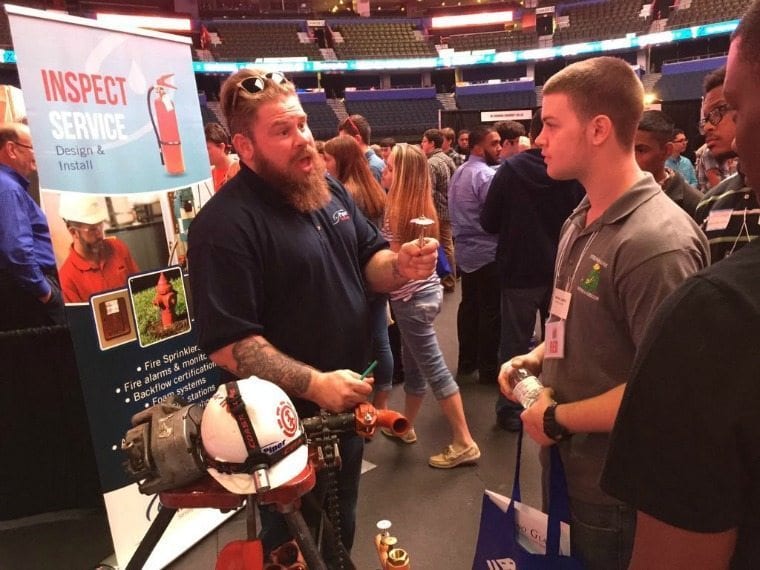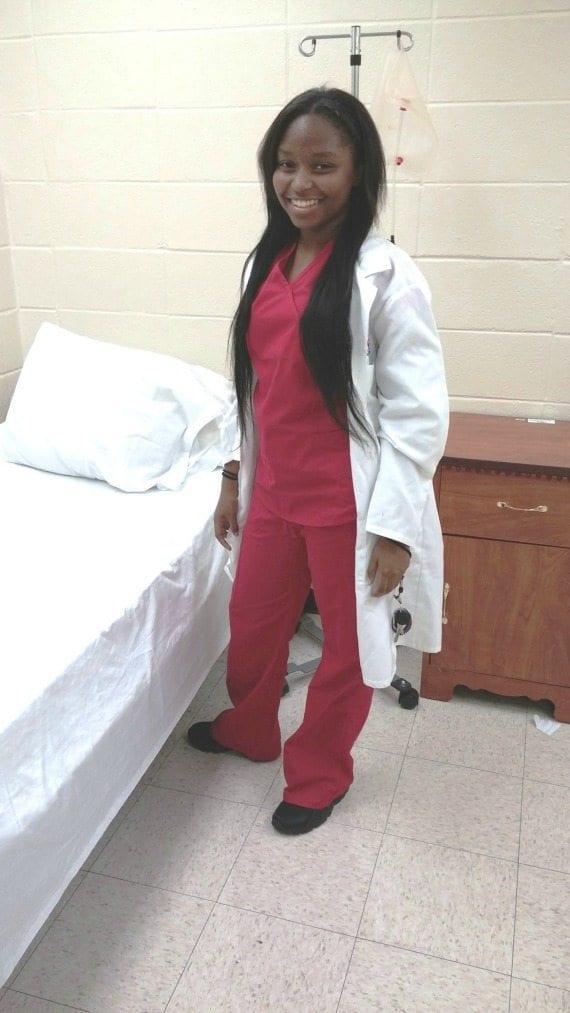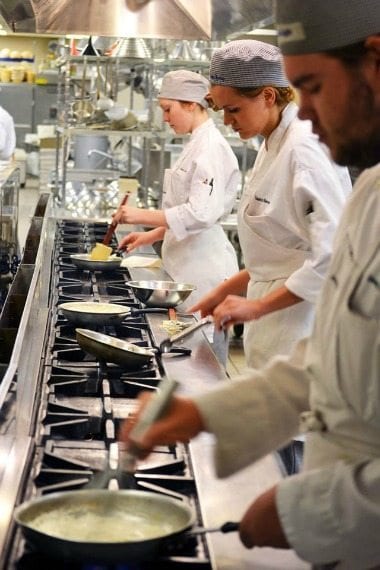What We Can Learn From Schools Witj Amazing CTE Programs
Courtroom reporting. Culinary blueprint. Automotive repair. For more and more high school students, career and technical courses are taking their identify right alongside English and math, whether students are planning to pursue a college degree or non.
And the benefits are clear. Consider these statistics from the Association for Career and Technical Education:
- The average graduation rate for students concentrating in CTE programs is 93 percent, compared to an average national freshman graduation rate of 80 per centum.
- More than than 75 percent of high school students who full-bodied in CTE pursued postsecondary education shortly after loftier school.
- Many of the fast-growing jobs through 2022 will be in the CTE fields including wellness care, the skilled trades, Stem, IT and marketing.
- A person with a CTE-related associate degree or credential will earn on average between $4,000 and $nineteen,000 more a year than a person with a humanities associate caste.
The quickly changing job market and tight budgets can make CTE programs a claiming. But some schools are connecting with employers and designing programs to equip students for growing high-wage, loftier-need CTE fields. Hither's a peek at four districts leading the way:

1. Hillsborough County Schools, Tampa, Florida
With 208,000 students, Hillsborough County is one of the largest districts in the land. In its 28 loftier schools and 43 middle schools, students tin have courses in one of 17 career clusters that include a variety of programs of study. The district emphasizes rigorous curriculum, existent-world applications and manufacture certification.
Ane of the nearly pop CTE programs is the veterinary banana program, according to Pamela Walden, supervisor of the agriculture and Junior ROTC program, who has been with the commune for 37 years. Students take v courses in the program from their freshman through senior years of high school and piece of work at a vet's office for easily-on experience. They can earn ix hours of college credit, and if they pass the test through the Florida Veterinarian Association, students receive a vet assistant certification.
What works:
- An early outset. Hillsborough is one of the few districts that brainstorm CTE in eye school. Sixth graders can accept a career enquiry development course to explore different careers and in seventh and eighth grades enroll in a career-tech grade based on their interest—from computers to culinary arts. "It really helps them focus on what they want to practice and gets them prepared for the direction they want to take," says Walden.
- Responding to business organization. The district works closely with employers to develop grooming that closely aligns with industry certification tests, says Walden. Each yr, nearly iii,000 students earn an manufacture certification. Programs are added and modified based on input from community partners. For example, the emphasis on STEM prompted the canton recently to develop an ag biotechnology program and studies in ag communications. Too, the technology surface area has expanded to include game design and TV production.
- Hosting manufacture-specific events. The county recently added a new position of "workforce director" to develop industry partnerships. The district but held an result called "Build Tampa Bay" that connected local construction, carpentry and engineering firms with students studying in those CTE programs. Employers set up booths in a big arena where they could interview interested students. Business partners paid to have about 700 students bused in from area schools, Walden says. The mayor, superintendent and school board members also attended. The district hopes to host similar events for other areas such as wellness care and IT, added Walden.

2. Whites Creek High School, Whites Creek, Tennessee
Virtually 10 years ago, Metro Nashville Public Schools went through a major transformation and developed wall-to-wall career academies in all of its high schools. Partnering with the business community, the district updated its programs to match the needs of the local workforce. Rather than an elective, career training is integrated into the curriculum for all students.
At Whites Creek Loftier School, students in grades 9–12 tin can choose to study a pathway in community health; alternative energy, sustainability and logistics; or teaching and police.
What works:
- A college and career approach. The focus is to prepare students for both college and career—rather than one or the other. Teachers work together to embed career preparation in academic courses, says Gaye Martin, CTE coordinator in the Nashville commune. At that place are interdisciplinary projects, for example, where students read Hamlet in English language class and exercise calculations of the criminal offence scene in math course. "It makes reading Shakespeare come live for them, infusing that entire perspective of criminal justice," she says.
- Incentives for success. Students can earn manufacture certification and early college credit while still in high school. In the criminal justice program at Whites Creek, money was solicited from private donors to assistance pay for the price of dual enrollment courses. Students pay a discounted fee of about $25 per class and the grant coin is used to reimburse them if they complete the course and earn the three hours of college credit. This non only gives these first-generation higher students a bound-start, it also instills confidence to handbag postsecondary education.
- Real-world experience. Students in the law pathway can act as attorneys, police-enforcement officers and court reporters in Youth Court, held in the schoolhouse's mock courtroom with a real juvenile justice judge presiding. There also are labs where they learn to do fingerprinting and use crime-scene equipment so students can get a glimpse of career possibilities while however in high schoolhouse.

3. Singley Academy, Irving, Texas
Strong career-tech programs need to exist continually improved and answer to market forces while maintaining rigor, says Shawn Blessing, CTE coordinator for the Irving Independent Schoolhouse District in Texas.
At Irving ISD's Jack E. Singley Academy, with 1,700 students in grades 9–12, that has meant recently expanding its offerings to include homeland security, cyber security and video game design. "The focus is on modify, the future and staying electric current. It's a very forward-thinking school," says Blessing.
What works:
- Community input. Each CTE cluster and specialty plan in the district has an active advisory lath with leaders from business concern and manufacture colleges, to help set goals, provide feedback and evangelize programs.
- Student recognition. The commune encourages students to exist involved in their career and technical student organizations, such as DECA, as well equally professional associations and honor societies. The school provides letter of the alphabet jackets to students who show outstanding performance in CTE, and the standards are higher than for other programs, according to Blessing.
- Workplace learning. Whether a paid or unpaid internship, a student-run enterprise in graphic design or culinary arts, students in strong CTE programs demand feel in their fields, says Approval. Some of Singley's programs have received national recognition for partnering with businesses and providing students with work-placed learning opportunities.

4. Eastward Valley Constitute of Technology, Mesa, Arizona
Students from school districts in the suburbs due east of Phoenix come to East Valley Plant of Technology for a half 24-hour interval of career training to pursue one of 40 programs. Classes are tuition-free for tenth–twelfth graders, who spend the other one-half twenty-four hours at their home schools in academic classes.
Since superintendent Sally Downey arrived at EVIT in 2000, she has seen the enrollment grow from 650 to nearly five,000 today. EVIT students have a 96 percent high school grad charge per unit and about two-thirds get on to higher. Nearly ten,000 visitors a year from around the country visit EVIT to learn what makes this CTE program thrive.
What works:
- Delivery to rigor. Graduating with a credential is key to the school's success. Nearly all programs prepare students to test for professional industry credentials, such as a Certified Nursing Assistant license or Automotive Service Excellence certification.
- Appropriate placement. Students coming into EVIT are asked most their interests and take a brief bent assessment. Their grades and omnipresence tape too are reviewed to make sure their program is the right fit. "Nosotros don't want to set kids up for failure. We want to set them up for success," says Downey.
- Engaged students. Instruction starts in the classroom and and then moves to the lab for hands-on experience in the culinary kitchen or automotive shop, says Downey. Sometimes students go off-site to a day-intendance facility for hands-on grooming. "They do what they learn in theory," says Downey. Since students are grouped by interest, they feel a sense of belonging and family unit inside the programs, she adds.
This blog is brought to you lot in partnership with iCEV. Register now to participate in CEV's autumn airplane pilot program, which will offer free access to thousands of curriculum resources for CTE.
Source: https://www.weareteachers.com/these-schools-have-amazing-cte-programs-and-heres-what-we-can-learn-from-them/